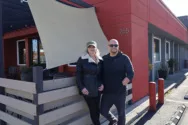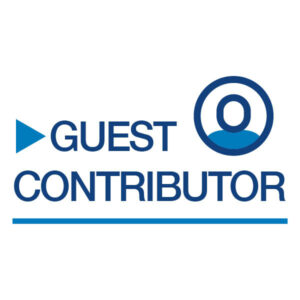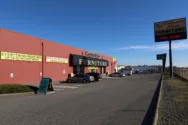
Home » HAB knows Hanford cleanup is a marathon, not a sprint
Hanford 2025
HAB knows Hanford cleanup is a marathon, not a sprint

April 14, 2025
Last year was a very special year for the Hanford Advisory Board (HAB) as it celebrated 30 years of volunteer service to the residents of the Pacific Northwest. For three decades, the HAB has provided values-driven, informed, consensus-based letters of advice, recommendations and white papers about Hanford cleanup.
We celebrated by holding an anniversary party on Feb. 6 and invited current and former HAB members and friends of the board. It was wonderful to see multiple generations celebrating this milestone together, and we are grateful to everyone who was able to attend.
HAB members carry out their duties with vigor by sharing information about Hanford cleanup activities and providing the Tri-Party Agreement (TPA) agencies with informed, policy-level advice.
Last year was a productive year for the HAB. We got back into a rhythm of providing guidance to the TPA agencies, passing five pieces of advice in 2024: Fiscal year 2026 Hanford cleanup priorities, comprehensive planning for disposition of Hanford’s transuranic waste, role of HAB alternate members, public comment response, and traffic safety. We encourage you to check out each piece of advice to see what issues the board was concerned about.
The TPA agencies released the Holistic Agreement at the end of April 2024 and the board was briefed on May 7, 2024. The agencies spent four years in closed-door negotiations before publicly releasing the settlement agreement, which proposed major changes to tank waste cleanup and schedules. The board actively tracked the negotiations over the past four years. Due to the timing, the board could not draft advice and get consensus approval before the end of the comment period. The HAB continues to closely follow activities related to the Holistic Agreement, for example, the West Area risk management project, the shipment of radioactive waste to Texas and Utah, direct-feed high-level waste and the cross-site transfer lines.
On Aug. 7, 2024, a group of board members toured the HAMMER Federal Training Facility and the maintenance and storage facility (MASF). The MASF is a full-scale mock-up of the Waste Encapsulation Storage Facility (WESF). In 2025, workers are expected to begin transferring the cesium and strontium capsules out of the pools in WESF and into dry storage casks. The mock-up at MASF provides a safe environment that allows workers to test and train on the equipment used for transferring.
The HAB held a regional meeting in September 2024 in Spokane. The board received updates from the Tri-Party Agreement agencies, a briefing on per- and polyfluoroalkyl substances (PFAS) at Hanford and passed three letters of advice. During public comment, the board heard from various Spokane residents, including Mayor Lisa Brown, who raised concerns about shipments of radioactive liquid waste traveling from the Hanford site through Spokane en route to disposal facilities in Texas and Utah. These are issues the HAB will continue to track in the coming years.
Hanford tours
Both new and existing HAB members toured the Hanford site in October as part of the new member orientation and learned for themselves the current state of the cleanup and preparations for future activities. The tour was an excellent way to go inside some of the major facilities on-site and gain a better understanding of how parts of the cleanup mission fit together.
The tour included a stop at the Cold Test Facility, a 500,000-gallon tank built to replicate most of the older single-shell tanks on Hanford’s Central Plateau. The facility is a safe, non-radioactive environment where workers test new equipment and technologies that can help remove tank waste. By standing inside the tank, board members appreciated the scale of one of Hanford’s smaller, 500,000-gallon tanks.
Also included were tour stops at the AP Tank Farms, the Tank-Side Cesium Removal System, the Low-Activity Waste Facility, the 200 West Pump and Treat Facility, the Environmental Restoration Disposal Facility, the Integrated Disposal Facility, 100 K Area, and the 324 Building. The site tour provided members with a tangible, comprehensive picture of the role these facilities play in Hanford cleanup.
Hot topics for HAB
Looking ahead, 2025 will be a busy year for the HAB. The board is closely tracking developments in the Direct-Feed Low-Activity Waste (DFLAW) program in preparation for hot commissioning. Issues and topics the board considers important and may write advice on in 2025 include worker safety, the path forward for soil remediation underneath the 324 Building, public involvement and transparent information sharing, sitewide cleanup priorities, the Hanford site permit (Rev 9A), and much more.
HAB’s diverse interests understand that a safe, environmentally sound, fiscally responsible cleanup is a marathon – not a sprint. We always consider the long-term cleanup goals as we work on current topics and issues. HAB members will continue to listen and learn; we are committed to working together to develop consensus advice to ensure our varied interests and values are included in agency decision-making related to Hanford cleanup.
We echo the statement by Susan Leckband, former HAB member and board chair: “Given the magnitude and longevity of the cleanup operations, it is imperative that we remain mindful to adhere to our most crucial priority, which is protection of public health and the environment, now and in the future. As a citizens’ advisory board, we keep those values in mind as we advise the U.S. Department of Energy, the U.S. Environmental Protection Agency, and the Washington State Department of Ecology to complete the Hanford cleanup mission in a timely, safe and cost-effective manner.”
It is crucial we stay true to our values and work together toward a protective cleanup of the Hanford site.
How to get involved
If you or your organization are passionate about the Hanford site cleanup and want to be involved in the process, consider becoming a member of the HAB! Positions are available each year.
For information contact:
- Jennifer Colburn, U.S. Department of Energy, at 509-376-5840.
- Ryan Miller, Washington State Department of Ecology, at 509-537-2228.
- Roberto Armijo, Environmental Protection Agency, at 509-713-8481.
Learn more about HAB and the work we at: hanford.gov/page.cfm/hab.
Susan J. Coleman is chair and Miya Burke is vice chair of the Hanford Advisory Board.
Hanford
KEYWORDS April 2025





